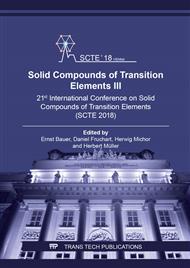p.65
p.71
p.77
p.85
p.93
p.102
p.108
p.114
p.120
Formation, Stability and Magnetism of New Gd3TAl3Ge2 Quaternary Compounds (T = Mn, Cu)
Abstract:
A study on the formation and stability of new quaternary compounds with the general chemical formula Gd3TAl3Ge2 (T = Mn, Cu) has been undertaken by experimental investigations (SEM-EDX, DTA and XRD) and density functional theory (DFT) calculations. These compounds crystallize in the hexagonal Y3NiAl3Ge2-type structure (hP9, P–62m, Z = 1) (an ordered, quaternary derivative of the ternary ZrNiAl or of the binary Fe2P prototypes), with lattice parameters values a = 7.0239(2) Å and c = 4.2580(1) Å for Gd3MnAl3Ge2 and a = 7.0434(1) Å and c = 4.2089(1) Å for Gd3CuAl3Ge2. DTA suggests a peritectic reaction for the formation of these compounds (at 1245°C for Gd3CuAl3Ge2). The existence and stability of these phases has been explained on the basis of DFT calculations, and a comparison of ground state properties of the studied compounds with the earlier known Gd3CoAl3Ge2 phase is outlined. The negative formation energies in all three cases govern the stability of compounds from theory as well, predicting Gd3MnAl3Ge2 as the most stable phase with highest formation energy (–13.01 eV/f.u.). The total DOS are generic in nature and suggest the robust magnetism, with the Gd-f moments of ≈7 μB. An antiparallel coupling among Gd-f and T-d states is observed for all compounds, as usually seen in rare earth (R) - transition metal (T) compounds. Preliminary magnetization measurements on Gd3MnAl3Ge2 show two ferromagnetic/ferrimagnetic (FM/FIM) like transitions at TC1 = 142 K and TC2 = 97 K, with another anomaly seen at ≈15 K. Isothermal magnetization data show no hysteresis even at 5 K, and the magnetization does not saturate up to 50 kOe, further suggesting a possible FIM behavior.
Info:
Periodical:
Pages:
93-101
Citation:
Online since:
April 2019
Price:
Сopyright:
© 2019 Trans Tech Publications Ltd. All Rights Reserved
Share:
Citation:


